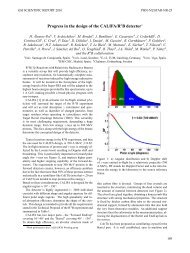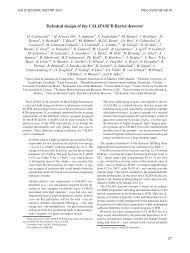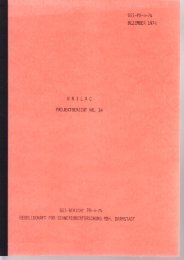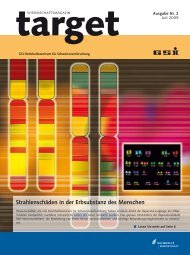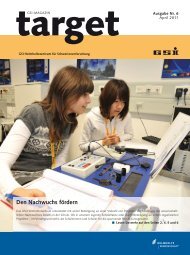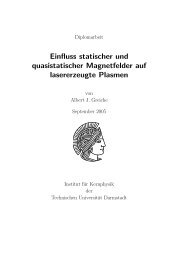download block - GSI Helmholtzzentrum für Schwerionenforschung
download block - GSI Helmholtzzentrum für Schwerionenforschung
download block - GSI Helmholtzzentrum für Schwerionenforschung
Create successful ePaper yourself
Turn your PDF publications into a flip-book with our unique Google optimized e-Paper software.
<strong>GSI</strong>-UPGRADE-ACC-09 <strong>GSI</strong> SCIENTIFIC REPORT 2009<br />
154<br />
<strong>GSI</strong>Template2007<br />
Status of the SIS 18 Vacuum Upgrade*<br />
M.C.Bellachioma, M.Bender, J. Cavaco, H. Kollmus, A. Kraemer, J. Kurdal, and H. Reich-Sprenger<br />
<strong>GSI</strong>, Darmstadt, Germany.<br />
In the context of the technical developments for the<br />
construction of the Facility for Antiproton and Ion Research<br />
at <strong>GSI</strong>, an intensive programme for the vacuum<br />
upgrade of the existing heavy ion synchrotron (SIS 18)<br />
was started in 2005, with the aim to improve the beam<br />
lifetime and the beam intensity. To reach these purposes<br />
the installation of NEG coated dipole and quadrupole<br />
chambers was foreseen, and additionally to overcome the<br />
dynamic vacuum instability a collimation system<br />
equipped with thin film coated absorbers was designed<br />
and commissioned.<br />
The production of the thin film getter was carried out in<br />
two cylindrical magnetron sputtering facilities described<br />
in details in Ref. [1]. The surface chemical composition<br />
and the good activation behaviour of the produced thin<br />
films (≈ 1μm thick) were proved at CERN and at the<br />
Magdeburg University by X-ray Photoelectron Spectroscopy<br />
(XPS). Considering that the vacuum chambers<br />
mounted in accelerators undergo several ventingactivation<br />
cycles, a deep investigation on the NEG ageing<br />
was performed last year at <strong>GSI</strong> by Elastic Recoil Detection<br />
Analysis (ERDA) [2]. In each activation cycle an<br />
identical quantity of oxygen is dissolved in the film bulk.<br />
However heating at temperatures lower than 250°C (as<br />
performed for the <strong>GSI</strong> coated chambers) does not allow a<br />
uniform oxygen concentration to be reached in the film<br />
and, as a consequence, oxygen atoms are settled in the<br />
film to form a concentration profile with the maximum<br />
close to the surface (see fig.1) which finally leads to accelerated<br />
performance degradation. The film degradation<br />
can be also explained in terms of C accumulation on the<br />
surface; in effect this element needs a higher heating temperature<br />
to be dissolved in the film bulk [3]. An abrupt<br />
reduction of the pumping speed was observed for thin<br />
coatings (0.25μm) after about 12 cycles when heating at<br />
200°C [4].<br />
Figure 1: The number of activation cycle is plotted from<br />
light to dark colour, carbon in red and oxygen in blue.<br />
* Work supported by EU design study, DIRAC-PHASE-<br />
1 RP6 SIS18-2 contract No. 515876.<br />
# cee@aps.anl.gov<br />
In parallel to the production and characterisation of the<br />
thin film getters an ion catcher system was designed and<br />
commissioned to guarantee that the loss of the charge<br />
exchanged particles behind the dipole chambers of the<br />
SIS 18 occurs on a low desorbing material and in a high<br />
pumping environment (assured by a NEG thin film).<br />
Lowest desorption was observed for gold coated copper<br />
targets, where a thin nickel film between copper and gold<br />
avoid diffusion of the materials into each other during the<br />
standard UHV bakeout. For this purpose a Ni film thickness<br />
around 200nm is sufficient [2, 5].<br />
Initially two geometries were realized: a wedge and a<br />
<strong>block</strong> shaped absorber. The first one, which separates the<br />
region where the losses occur from the circulating beam,<br />
has the disadvantage that the particles hit the absorber<br />
under grazing incident causing high desorption. The second<br />
one, which can be placed in the correct position by a<br />
linear motion feedthrough guarantees instead perpendicular<br />
incident with the disadvantage of an open geometry.<br />
Experiments have shown [5] that the <strong>block</strong> shaped absorber<br />
has a lower desorption yield on the level of 25<br />
molecules per incident ion. Therefore it represents the<br />
favourite solution for the ion catcher system.<br />
At the end of 2008 two ion catcher prototypes, 14<br />
coated dipole chambers and one quadrupole chamber<br />
were implemented in the SIS18. First experiments to<br />
evaluate the vacuum upgrade achievement showed a clear<br />
improvement in achievable U 28+ beam lifetime caused by<br />
the upgraded UHV system [6].<br />
During the 2 upgrade shutdowns in 2009 all the remaining<br />
coated dipole and quadrupole (except for the one in<br />
S11) chambers and ten ion catcher were mounted in the<br />
accelerator. In summary, during the upgrade shutdowns<br />
from 2006 to 2009 24 dipole magnet chambers, 11 long<br />
quadrupole chambers, 5 short quadrupole chambers, 10<br />
collimator chambers and 5 straight vacuum chambers<br />
were replaced by NEG-coated UHV chambers, which<br />
corresponds to app. 65% of the SIS 18 circumference.<br />
Commissioning of the UHV system upgraded will be performed<br />
in the beginning of 2010. Detailed measurements<br />
of the improved performance will follow in 2010.<br />
References<br />
[1] M.C.Bellachioma et al., Vacuum 82 (2008), p.435-<br />
439.<br />
[2] M.C.Bellachioma et al., Proceedings of PAC09,<br />
Vancouver, BC, Canada.<br />
[3] P.Chiggiato and P.Costa Pinto, Thin Solid Film 515,<br />
(2006), p.382-388.<br />
[4] P.Chiggiato et al., unpublished, to be submitted to<br />
J.Vac.Sci.Technol. A.<br />
[5] Kollmus et al., this <strong>GSI</strong> Annual Report<br />
[5] G.Weber et al., Phys.Rev.STAB, 12, 084201 (2009).


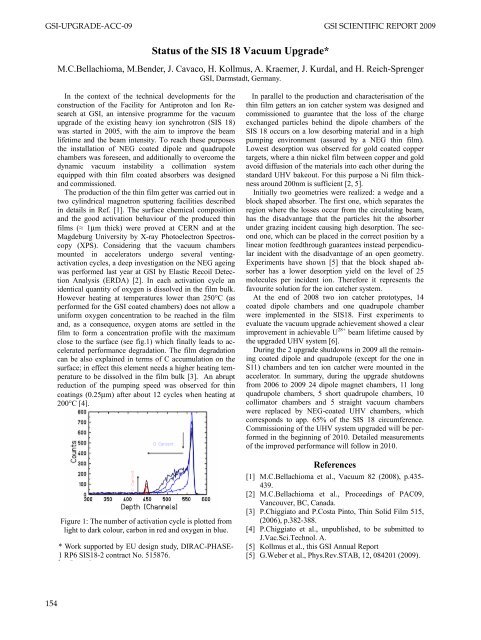


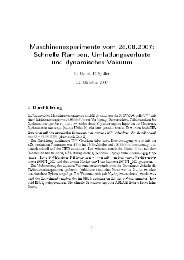
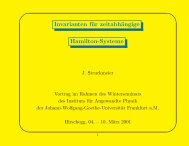
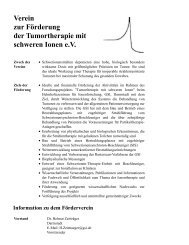
![GS I -P-]-17 - GSI Helmholtzzentrum für Schwerionenforschung](https://img.yumpu.com/20698964/1/184x260/gs-i-p-17-gsi-helmholtzzentrum-fur-schwerionenforschung.jpg?quality=85)

